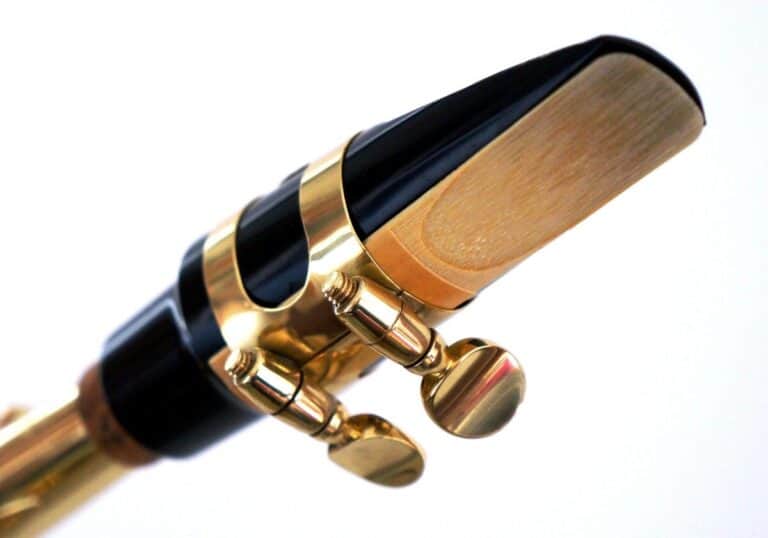Saxophone Low Notes Not Working? Here’s How To Fix It Fast
I think every saxophonist has had a point in their lives in which they struggled with low notes. If this is a problem that you are currently having, hopefully this article can help you out.
The most common reason why low notes do not work is a leak in the instrument. This can be fixed either by adjusting screws and pads or shifting the alignment of the bell. Difficulty playing the low notes of the saxophone can also be caused by air leaking from an improper neck to body fit.
It is commonly said that low notes are all about air support. While this is true, you also need to have a perfectly functioning instrument for low notes to work well. Therefore, I recommend getting your instrument checked for leaks before making major changes to the way you play.
With that being said, let’s get into the major causes and their respective solutions.
There are essentially three common issues you will have with low notes:
- The low notes are warbling.
- The low notes come out as an octave higher.
- The low notes honk.

If your low notes are warbling
Low notes warble when a screw on the regulation bar (rod which presses down the G sharp key when anything on the right hand is pressed) is too loose. This problem can be solved by tightening the screw found just above the G sharp key.
The G Sharp key is normally closed by default, and pressing the key opens it. However, it is closed when anything on the right hand is pressed. This is done by the regulation bar.
Sometimes, the screw on the regulation bar just above the G Sharp key is too loose. This results in the G Sharp key not fully closing, and as such it leaks whenever you try to play low notes. This in turn produces the warbling sound.
The simplest solution is to grab a screwdriver and tighten the screw above the G Sharp key. You have to be careful about how much you tighten it though, because if you go too far then the F key will not close. Therefore, if you are having this issue then I recommend tightening it in very small increments.
After tightening in a small amount, try playing your saxophone again and see if the problem is solved. If not, repeat the process of tightening the screw. Continue until your low notes are functional. If you are unable at any point to press down the keys on your right hand, loosen the screw a little bit.
A possible quick fix
If you do not have access to a screwdriver to tighten the screw, there is a temporary solution which you can try.
Find a small object (such as your end plug, mouthpiece cap, small stone, marble, coin, etc.) and place it in the bottom of your bell. This messes with the acoustics of the instrument in such a way that it may prevent the warbling.
I find that the solution tends to be hit or miss. It may be worth testing it out, if you are able, before you commit to using it. In any case, fixing the screw on the regulation bar is in my opinion a much better solution.
Here is also a video that teaches you how to do some basic saxophone repairs on your own:
If your low notes are an octave too high
Low notes come out an octave too high most commonly due to the neck octave pad not closing properly, or a tight embouchure/weak airstream. If the octave pad is not sealing the tone hole well, this is a relatively easy fix by a trained technision. You can try opening your throat/oral cavity and play with a loose embouchure to make sure the higher overtones do not come out.
There are essentially two likely causes here.
If neck octave pad is not sealing, there isn’t really anything you can do about it except to take it to a repair person (preferably one who specializes in the saxophone). I would recommend to not try and bend the key and fix it yourself as you could make matters worse. You should also ask the repair person to check the saxophone for leaks, which could also cause the same issue. Keep in mind that the octave key operates by creating a tiny leak in the instrument, so any leak that is unintentional could also cause the pitch to jump up an octave.
As any problems with your saxophone which might be responsible for this issue are most likely out of your control, it is more worthwhile for you to work on honing your breathing and embouchure to make sure that those are not the reason that you are struggling. As those types of problems can cause issues beyond just having the low notes pop out an octave too high, however, we’ll save them for the end of this article. You can scroll toward the bottom if you just want to learn how you can adjust your playing.
Keep in mind, though, that no amount of adjusting your playing will help you with your low notes if your saxophone isn’t working properly.
If your low notes honk
Honky low notes are usually caused by having an embouchure which is so loose that it causes the sound to split. The solution here is to avoid altering your embouchure while playing low notes. If you are still unable to play low notes after doing this, then your saxophone likely needs repair.
Honky low notes have a different cause than the other issues I’ve covered here. Whereas the other issues are commonly caused by problems with the saxophone, a honky sound from my experience is most commonly caused by the player.
This is a problem which is especially common in beginners. As low notes tend to have more complex fingerings and require more deliberate effort, beginners tend to sometimes forget about their embouchure and allow it to become looser. They may alternatively tighten their embouchure, which can cause the same problem (though it is more likely to cause low notes to jump up the octave).
If you are struggling with a honky sound, you most likely need to make sure that you are not changing anything about the way you play as you go into the lower register. As an exercise, you can start playing in the middle register and slowly slur down to the lower notes. Focus deliberately on your embouchure as you do this, to make sure that you are not changing anything.
It may also be a possibility that you have learned to deliberately change your embouchure as you play low notes. This is a bad habit which often develops to compensate for an instrument which is not functioning well.
You will probably have an easier time playing low notes if you do not adjust your embouchure. If you feel that adjusting your embouchure is the only way you can play low notes, then either:
- Air is leaking out from somewhere, and you may need to take your instrument in for repairs, or
- Your embouchure is wrong, and you should scroll down to the section on embouchure to see my recommendations on how to fix this.
Alternatively, you may not be using adequate air support, which can also cause you to be unable to play low notes without making adjustments. In that case, the solution is to work on your air support while being sure to keep a consistent embouchure in the lower register.
Adjustments in your playing

Embouchure and low notes
Using an embouchure which is too tight will cut off the vibration of the reed, making low notes much more difficult to play. In order to get low notes to pop out, you may need to practice mouthpiece exercises that train you to deliberately play with a looser embouchure.
The main issue here is having an embouchure which is too tight. Granted, an excessively loose embouchure will cause problems as well, but tight embouchures are known to cause issues with low notes.
There is an exercise you can use to train yourself to use the correct amount of jaw pressure on the reed. Have your mouthpiece (with reed and ligature) but don’t put it on the neck of the saxophone. You’re going to play on just the mouthpiece. Make sure you also have a tuner.
Play on just the mouthpiece at your loudest possible volume (and please use hearing protection!). Measure the pitch with your tuner. You’re aiming for a specific pitch depending on the type of saxophone you play:
Soprano sax: Concert C
Alto sax: Concert A
Tenor sax: Concert G
Baritone sax: Concert D
Adjust the amount of jaw pressure you use on the reed until you are able to achieve the pitch you are aiming for. However much jaw pressure it takes you to achieve that pitch is the amount of jaw pressure you should be using when you play saxophone.
You will most likely find that this requires your embouchure to be significantly looser. This will help you make sure that you are not biting when it comes to playing low notes.
Air support and low notes

As you play lower in the range of the saxophone, you will need to use more force behind your air to produce a sound. This is most likely only achievable through diaphragmatic breathing, and as such will need to master it in order to get your low notes to pop out.
There are actually two ways that you can breathe. The first is from the chest, and this kind of breathing tends to be fairly shallow. The other way is from the diaphragm, in approximately the stomach area. This allows for much deeper breathing.
Most people breathe from the chest. This is a problem for playing the saxophone, however, as the saxophone requires an amount of air support that breathing from the chest cannot offer. This is especially true for low notes, because a shallow breath simply will not allow the low notes to speak.
It is commonly said that low notes are all about air. While I don’t believe this is exactly true (considering I spent most of this article listing off problems with the saxophone which can inhibit low notes), it is undeniable that using proper air support is an absolute necessity if you’re going to get your low notes to sound good. So, you’re going to have to learn to breathe from the diaphragm if you do not already know how to do so.
There is an exercise which you can use to help you breathe from the diaphragm if you do not already know how to do so. To start, find a spacious area around you and lie down on your back. Then, simply breathe normally. Most people naturally breathe from their diaphragm while lying down, but breathe from their chest the rest of the time. So, if you lie down, you’ll most likely be able to breathe from your diaphragm. Do this for a few moments, and try to memorize what this feels like.
Then, stand up and see if you can breathe from your diaphragm while upright. If you can, then you have gotten the hang of the kind of breathing that you need to use while playing the saxophone.
However, there is one more step. Not only do you need to breathe from the diaphragm while playing the saxophone, but you need to make sure you are taking full breaths.
Before playing your instrument, first exhale the air currently in your lungs. This air may have already been in your lungs for a while, and won’t offer much air support. Then, take a full, deep breath from only the diaphragm. Fill up your diaphragm completely, but don’t start filling the chest.
This is the type of breath that you should use before playing the saxophone. If you support your low notes with this type of breath, then your low notes will pop out much more easily.
Conclusion
Low notes are often difficult for saxophonists, especially beginners. They don’t have to be, though. My hope is that this article has helped you either solve or make progress toward solving your low note troubles.
If you did find this helpful, you may also find benefit from other articles on this site. We have a whole bunch of saxophone-related content intended to help musicians like yourself.
Otherwise, I wish you the best of luck in developing a consistency in your low notes that you may currently lack.






